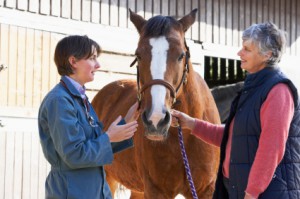 Nutrition plays a role in the success of all parts of the breeding season, from mares, to foals, and even stallions. Much research has been done investigating the impact of nutrition on the reproductive function of mares and the development of foals, but there hasn’t been a great deal of research investigating the nutritional requirements of breeding stallions. It has been estimated that during breeding season, the daily nutrient requirements are 25% above maintenance of a mature stallion during the off season. However, all stallions don’t have the same requirements in the off-season, so their nutritional needs aren’t all the same during breeding season.
Nutrition plays a role in the success of all parts of the breeding season, from mares, to foals, and even stallions. Much research has been done investigating the impact of nutrition on the reproductive function of mares and the development of foals, but there hasn’t been a great deal of research investigating the nutritional requirements of breeding stallions. It has been estimated that during breeding season, the daily nutrient requirements are 25% above maintenance of a mature stallion during the off season. However, all stallions don’t have the same requirements in the off-season, so their nutritional needs aren’t all the same during breeding season.
Some stallions are young and may even still be growing so their nutritional needs will be different from a mature stallion. Those that are still showing through the breeding season will have different requirements from those that stay on the farm the whole season. Breeding season will place additional demands on each of them, but the base diet will be different. Basically, a stallion should be fed according to his current lifestyle, then make adjustments based on how busy his breeding season may be and how hard he has to work.
It is very important to monitor a stallion’s body condition before and during the season. Results of one study showed that stallion body weight decreases during peak breeding activity when feed intake remains constant. So, feeding rates and maybe even the product fed may need to be adjusted for a heavy breeding season. Ideally, stallions should be kept in performance condition, where ribs are not visible but are easy to feel. A thin stallion is not receiving adequate calories in the diet and is possibly deficient in other important nutrients like protein, vitamins and minerals. This can affect libido and possibly fertility. On the other hand, overweight stallions have been reported to have reduced libido, in addition to having long-term negative effects on health due to excess weight on joints and other metabolic problems associated with obesity. Basically, a stallion should be treated as an athlete, which means that he should receive regular exercise and turn out. This is important for both physical and mental well-being.
For young stallions still growing and/or showing through the breeding season, good quality hay and a well balanced feed that provides quality protein, vitamins and minerals to support growth and performance will be important. Simply increasing the amount of feed to meet additional calorie needs will support the additional nutrient demands of breeding season. Older, more sedentary stallions can often maintain adequate condition in the off-season on hay or pasture alone and may not require the additional calories supplied in most feeds. However, hay or pasture won’t provide all the nutrition they need for long-term health and many of these stallions cannot eat the recommended levels of typical mixed feeds without getting overweight. If the feeding rates are reduced to prevent the weight gain, then they often become deficient in important nutrients. A general rule of thumb should be that if a horse doesn’t eat at least 3.5 – 4 lbs per day of a well balanced, nutritionally fortified feed, then they are probably coming up short in some nutrients. In those cases, a product that is fortified to provide the needed protein, vitamins and minerals in 1-2 pounds per day would be a good choice.
For sub-fertile stallions, there have been studies looking at adding certain nutrients to the diet with the hopes of increasing fertility. Stallions in their late teens or twenties with reduced fertility have been reported to have improved fertility when their diets were changed from oats to Purina Equine Sr. No studies have identified what specific nutrients may be responsible for the improved fertility. Supplemental vitamin C and E have been proposed to increase stallion fertility.
However, numerous controlled studies have failed to show any benefit, especially if these vitamins are added to an already well fortified diet. Several universities have reported improvement in motility of cooled or frozen semen from stallions fed a supplement containing DHA (docosahexaenoic acid), a marine-based omega-3 fatty acid. Similar benefit was not seen when supplementing with ALA (alpha-linolenic acid), omega-3 fatty acid found in flax and other plant oils. This may be worth investigating for those stallions whose semen doesn’t ship well. For most stallions, sticking to a well balanced feed with good quality hay and providing regular exercise will meet all the requirements for a fertile and successful breeding season.
Source: Dr. Karen Davison, Equine Nutrition, Purina Mills
Tags: Horses